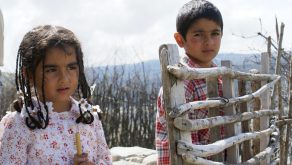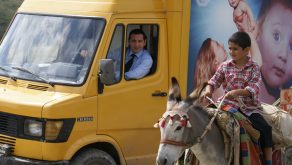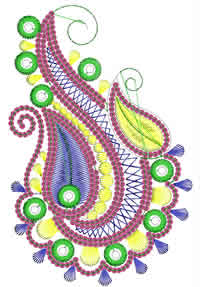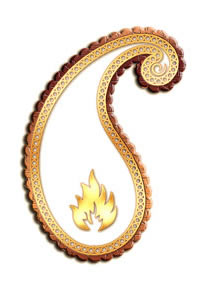“Directors often feel like Christopher Columbus”
 7-year old Buta lives with his grandmother in a mountain village in Azerbaijan. Life seems easy: Buta goes to school, plays with his girlfriend, fights a group of envious boys and meets a new friend and tutor, an old soap seller encouraging him by his worldly wisdom and telling him stories from a long gone past.
7-year old Buta lives with his grandmother in a mountain village in Azerbaijan. Life seems easy: Buta goes to school, plays with his girlfriend, fights a group of envious boys and meets a new friend and tutor, an old soap seller encouraging him by his worldly wisdom and telling him stories from a long gone past.
Buta is not just a name, it’s also a pattern on the carpets that the women in the village are weaving. Looking like a drop of water (see picture), it has a rich symbolic meaning. Looking closely, you’ll find buta’s everywhere in this film.
Ilgar Najaf: “From the beginning of the film when the meaning of the symbol is explained, the buta is omnipresent. As it is in life; buta relates to all aspects of life and its meaning differs for every individual. For the main character, buta symbolizes his entire life – he is even named after the ornament, Buta. On top of the hill, he is piling up a buta in stones, carrying them uphill like he carries every burden on his shoulders. That’s his life’s destiny.”
 What is the ethnical and geographical background of the story?
What is the ethnical and geographical background of the story?
Najaf: “The film was shot in a mountain village 150 kilometers from Baku. The type of fighting amongst children in the film, is typical for that region. We call it ‘chicken fights’; I was good at it as a child. In Azerbaijan ethnicity isn’t much of an issue, although people in the North and South might wear different costumes or have different traditions. But weaving carpets is something all Azeri’s have in common, up till today.”
For a western audience it’s hard to imagine people living under such primitive circumstances.
Najaf: “The film isn’t about the hardships of a life without luxury, but about relations between people. Age doesn’t make a difference. Buta is 7 years old, his best friend is 70; mankind doesn’t make a difference when it comes to ages. But that kind of village life hardly exists anymore. Small changes have a big impact on ancient traditions. Those changes have come, and even if it’s not a good thing, there is little we can do about it.”
You call those changes detrimental?
Najaf: “Globalization swallows the nature of traditions. Globalization seems pretty dull to me: like a big stomach swallowing everything and digesting it into a grey mass.”
 Many events take place under the big tree. What is its role in the story?
Many events take place under the big tree. What is its role in the story?
Najaf: “The lonesome tree is a conspicuous element in the film. He is a witness, an omnipresent observer. He has seen everything: love, youth, age and death. His role continues up until the end of the movie. There are 4 sceneries in the closing sequence, shot from a helicopter: a marriage, a stone pattern, carpets… and the tree, as a last farewell. People die but the tree remains.”
The parallels between generations are a key element to the story. How do all generations connect to each other?
Najaf: “In the village, a small universe of its own, 3 generations are connected mainly through love. Buta and his girlfriend show you love in its earliest stage. There are also the love stories between a young girl and a travelling salesman, and between an old man and a grandmother. Through different generations I could show love in all its aspects.”
Main actor Rafig Azimov is amazing. How did you work with him?
Najaf: “Although Rafig is a smart kid, he is only 7 and I knew it was going to be tough for him. Therefore I planned 45 days of rehearsal, which didn’t exactly please the older actor, a renowned Azeri professional. On screen there is always a clash between professionals and non professionals and I didn’t want the audience to see or feel that in the movie.”
Directing a large group of children, was it difficult to channel their energy?
Najaf: “Honestly, if I would have known that working with children was so difficult, I never would have even started this project. The young actress was only 5. How to explain her about responsibilities? As a debuting director I found it extremely hard. For instance, the scenes with the children in the river we shot in September when it’s was already cold. Azim (Buta’s nemesis) and the others didn’t want to go into the water. Finally we found a solution: we rubbed their bodies with vodka to heat up the skin, then they played a short scene, and after every take we rubbed them with vodka again.”
 Did this situation put you under pressure?
Did this situation put you under pressure?
Najaf: “From the day the shooting started, I realized I was in trouble. But there was no turning back. A director on the set often feels like Christopher Columbus: he knows that at the end of the ocean, there is land, but the rest of the ship’s crew doesn’t believe there is.”
Have the people from the village already seen the film?
Najaf: “Yes! That was one of the best screenings we had.”
Can you tell a bit more about the carpet tradition?
Najaf: “Looking at a handmade carpet, the patrons reveal about the woman who made it. You can tell about her character and her moods, if she felt happy or sad or maybe in love. Like Buta’s grandmother says, ‘weaving a carpet, you can’t hide your true self’. You can read things in the use of the colours and patterns. The symbolic use of buta’s is a good example: 2 buta’s entwined means love, a big and a small buta means mother and child, 2 buta’s backwards to each other means separation, a buta with a big belly means pregnancy, etc. This is a graphic language developed by non-educated women from the villages.”
Did you do the same: weaving your own symbolic language into your film?
Najaf: “Each director puts something of himself in his movies. I recognize myself in the main character. I particularly admire his honesty; he always strives to be fair. That is what I would like to see in every person; that is my ultimate dream.”
My last question comes from the movie itself: what is better, a car or a donkey?
Najaf: “Like the question, the answer is in the movie. Living in a village like Buta, I would definitely choose the donkey!”
Gert Hermans
